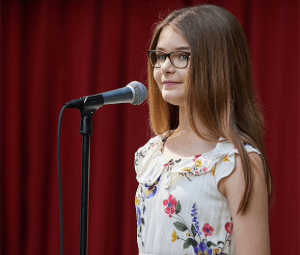- Faith and Music in Lessons at Downingtown Music Academy
- Why It’s Never Too Late to Return to Music Lessons: Stories, Tips, and Inspiration
- How Themed Practice Incentives Make Music Lessons More Fun and Effective
- Why Music is So Important for Neurodiverse Children
- What to Expect: How Long Does It Take to Learn an Instrument or Sing?
- Being Mindful of How the Body Feels When Singing
- Back to School: How Music Lessons Can Enhance Your Child's Academic Performance
What kind of music should I sing as a beginner?

Many of my students just starting lessons wonder: "what kind of music should I sing as a beginner?" Let me first start out by saying: I don't want to be the person to choose your music. I am personally of the viewpoint that the job of a music teacher is to be a guide rather that a dictator. I usually encourage my students to select music that they connect with and makes them feel inspired. I'm not a country music fan. BUT, if the student is, and it brings them joy, then I'm not going to steer them away from country. It's not my job.
So, what is my job?
My job is to help a voice student's voice to be the best version of their voice it can be. I'm give my students syllabic, breathwork, pitch training and muscle manipulation exercises. The student learns how to achieve a relaxed, pure sounding voice that can be stylized to fit the music of their choosing. That being said, a beginning singer shouldn't just be diving into Aretha Franklin or Demi Lovato until they have the vocal chops to do so safely. If this is the student's ideal music choice, we pick songs that have a similar vibe. We also might simplify the music so it's not as athletically challenging for them. So as far as music choices, I'm here to tell you that its more about what to AVOID. So, I ask my beginning students to come up with a list of songs they enjoy. We go through that list together (because we are team) and make sure that we avoid the following types of songs:
Songs with Crazy Riffs
Think Ariana Grande, Whitney Houston, and Mariah Carey. Your vocal divas. Riffs are sequences of moving pitches that are sung on one syllable of a word. Riffs are generally very difficult for beginning singers. Beginners haven't yet developed the precision of pitch, vocal cord muscle control and proper breathing skills to support these fast vocal movements with enough accuracy. Imagine if a beginning gymnast tried to accurately execute a series of flips and round off back handsprings. You need to start with the basics before you're ready for riffs. If a singer is really fixated on performing a song by one of these artists, I usually rewrite the melodies. I simplify them so that we remove the riffs until the singer has mastered their foundational skills first.
Songs with Belting
Think "Defying Gravity" from Wicked or "Man! I feel like a Woman" by Shania Twain. When belting, a singer employs more chest voice in their upper range to achieve a stronger sound. Don't try this at home without a vocal teacher's guidance! Belting isn't neccessarily unsafe, but if it's done with the incorrect form, it can be. Comparing singing again to exercise, you don't want to try and life 200 lbs when you haven't mastered your weight lifting form at 50 lbs. You would hurt yourself! Belting is strength training for the voice. In order to be ready to belt, you need to have-you guessed it-mastered the basics first. You also should be old enough to do it safely. I don't work on belting with kids under 15 because their voice is still developing stability at this age, and their instrument is simply not as big as an adult's and it will not produce the right amount of volume until it gets bigger. I don't want anyone yelling through their songs! Again, if a beginning singer is really fixated on doing a song that happens to include belting, we don't belt.
Songs that move too fast or have really looooong phrases
Think "Modern Major General" from Gilbert and Sullivan's Pirates of Penzance. When a song moves too fast or has too long of phrases it can be impossible for a beginning singer to practice because the endurance for breathing is just not there yet. In these cases I steer the student away from the song in question because it usually isn't something we can change. We can revisit it later when the student is ready.
Songs that "leap" from high to low or low to high
Think "Somewhere over the rainbow" from The Wizard of Oz or "Elastic heart" by Sia. A beginning singer is still mastering their control over the muscles that support their vocal cords. Because vocal cords need to stretch to reach higher pitches and contract to reach lower ones, beginning singers often struggle with keeping their cords stable in songs with big leaps. This results in cracking, strain and shaky vocal transitions. This is again not something we can change without the melody changing (which would change the song!) In these cases, I again encourage the student to choose another song. We can revisit it later when they student are ready.
A quick note about something that DOESN'T matter..
The overall pitch of the song doesn't matter. If it's sung by a man, and the student is female, or an alto and they are a soprano, it's no big deal. We can transpose the music to suit the student's range. I use computer software to move the audio file higher or lower until the student is comfortable with the range and it flatters their voice. Now that we've answered your question: "what kind of music should I sing as a beginner?", get your FREE practice kit and start working on that song!